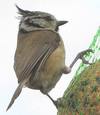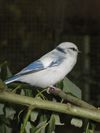Genus Parus
Grey Tit - The Grey Tit is a species of bird in the Paridae family. It is found in Lesotho and South Africa. Its natural habitats are subtropical or tropical dry shrubland and Mediterranean-type shrubby vegetation.
White-breasted Tit - The White-bellied Tit is a species of bird in the Paridae family. It is found in Cameroon, Kenya, Nigeria, Sudan, Tanzania, and Uganda. Its natural habitats are subtropical or tropical dry forests and subtropical or tropical moist montane forests.
Parus amabilis - The Palawan Tit is a species of bird in the tit family Paridae. It is endemic to Palawan and the smaller islands of Calauit and Balabac in the Philippines. Within its range it is found in lowland forest habitats, including secondary forests, forest edge, swamps as well as submontane forest. It feeds on small insects, insect larvae, seeds, and fruit. It generally occurs singly or in pairs, and will join mixed-species feeding flocks.
Parus ater - The Coal Tit, Periparus ater, is a passerine bird in the tit family Paridae. It is a widespread and common resident breeder throughout temperate to subtropical Eurasia and northern Africa. The Spot-winged Tit is sometimes included in this species; this may be correct, but more research is required to determine that species' status.
Black Capped Titmouse - The Black-capped Chickadee is a small, common songbird, a passerine bird in the tit family Paridae. It is the state bird of both Maine and Massachusetts, and the provincial bird of New Brunswick in Canada.
Turkestan Tit - The Great Tit is a distinctive bird, with a black head and neck, prominent white cheeks, olive upperparts and yellow underparts, with some variation amongst the numerous subspecies. It is predominantly insectivorous in the summer, but will consume a wider range of food items in the winter months. Like all tits it is a cavity nester, usually nesting in a hole in a tree. The female lays around 12 eggs and incubates them alone, although both parents raise the chicks. In most years the pair will raise two broods. The nests may be raided by woodpeckers, squirrels and weasels and infested with fleas, and adults may be hunted by Sparrowhawks. The Great Tit has adapted well to human changes in the environment and is a common and familiar bird in urban parks and gardens. The Great Tit is also an important study species in ornithology.
Parus caeruleus - The Blue Tit, Cyanistes caeruleus, is a 10.5 to 12 cm long passerine bird in the tit family Paridae. It is a widespread and common resident breeder throughout temperate and subarctic Europe and western Asia in deciduous or mixed woodlands. It is a resident bird, ie.
Florida chickadee - The Carolina Chickadee, Poecile carolinensis, is a small passerine bird in the tit family Paridae. Often, it is still placed in the genus Parus with most other tits, but mtDNA cytochrome b sequence data and morphology suggest that separating Poecile more adequately expresses these birds' relationships . The American Ornithologists' Union has been treating Poecile as distinct genus for some time already.
Alaska chickadee - The Siberian Tit or Gray-headed Chickadee is a passerine bird in the tit family Paridae. It is a widespread resident breeder throughout subarctic Scandinavia and northern Asia, and also into North America in Alaska and the far northwest of Canada. It is a conifer specialist. It is resident, and most birds do not migrate.
Acacia Grey Tit - The Ashy Tit is a species of bird in the Paridae family. It is found in Angola, Botswana, Namibia, South Africa, and Zimbabwe. Its natural habitats are subtropical or tropical dry forests and dry savanna.
Parus cristatus - It is an easy tit to recognise, for besides its erectile crest, the tip of which is often recurved, its gorget and collar are distinctive. It is, like other tits, talkative, and birds keep up a constant zee, zee, zee Birdsong , similar to that of the Coal Tit .
Parus cyanus - It is found in temperate and subarctic deciduous or mixed woodland, scrub and marshes. It is resident, and most birds do not migrate. It nests in a tree hole, laying about 10 eggs. The bird is a close sitter, hissing and biting when disturbed. Its food is insects and seeds.
Parus davidi - The Rusty-breasted Tit or Père David's Tit is a species of bird in the tit family Paridae. It is endemic to west-central China in southern Gansu, western Hubei, southern Shaanxi, and Sichuan.
Parus dichrous - The Grey-crested Tit is a species of bird in the Paridae family.
Parus elegans - The Elegant Tit is a species of bird in the tit family Paridae. The species was formerly included in the much larger genus Parus, and some authorities have suggested that along with the closely related Palawan Tit and Yellow-bellied Tit it should be placed in a new genus, Pardaliparus. The species has nine recognised subspecies, one of which, the race P. e. panayensis from Panay, is potentially a separate species. It is endemic to the Philippines, ranging across most of the islands.
Parus flavipectus - Its natural habitat is temperate forests.
Dusky Tit - The Dusky Tit is a species of bird in the tit family Paridae. It is found in Angola, Cameroon, Central African Republic, Republic of the Congo, Democratic Republic of the Congo, Ivory Coast, Gabon, Ghana, Guinea, Kenya, Liberia, Rwanda, Sierra Leone, Sudan, and Uganda. Its natural habitat is subtropical or tropical moist lowland forests.
Bailey's chickadee - The Mountain Chickadee is a small songbird, a passerine bird in the tit family Paridae. Often, it is still placed in the genus Parus with most other tits, but mtDNA cytochrome b sequence data and morphology suggest that separating Poecile more adequately expresses these birds' relationships . The American Ornithologists' Union has been treating Poecile as a distinct genus for some time.
Northern Grey Tit - The Miombo Tit is a species of bird in the Paridae family. It is found in Angola, Democratic Republic of the Congo, Malawi, Mozambique, Tanzania, Zambia, and Zimbabwe. Its natural habitat is subtropical or tropical dry forests.
Formosan Yellow Tit - Its natural habitat is montane temperate forest.
Acadian chickadee - The Boreal Chickadee is a small passerine bird in the tit family Paridae.
White-winged Black-Tit - The White-winged Black Tit Parus leucomelas, also known as the White-winged Tit, is a passerine bird in the tit family Paridae. It is found in central Africa, from Angola in the west to Ethiopia in the east.
White-backed Black-Tit - The White-backed Tit is a species of bird in the Paridae family. It is found in Eritrea and Ethiopia. Its natural habitat is boreal forests.
Parus lugubris - The Sombre Tit is a member of the tit family found in southeast Europe and southwest Asia.
Great Tit - The Great Tit is a distinctive bird, with a black head and neck, prominent white cheeks, olive upperparts and yellow underparts, with some variation amongst the numerous subspecies. It is predominantly insectivorous in the summer, but will consume a wider range of food items in the winter months. Like all tits it is a cavity nester, usually nesting in a hole in a tree. The female lays around 12 eggs and incubates them alone, although both parents raise the chicks. In most years the pair will raise two broods. The nests may be raided by woodpeckers, squirrels and weasels and infested with fleas, and adults may be hunted by Sparrowhawks. The Great Tit has adapted well to human changes in the environment and is a common and familiar bird in urban parks and gardens. The Great Tit is also an important study species in ornithology.
Parus melanolophus - It is closely related and similar to the Coal Tit, and is sometimes considered to be conspecific. It interbreeds with that species in western Nepal.
Parus montanus - The Willow Tit is a passerine bird in the tit family Paridae. It is a widespread and common resident breeder throughout temperate and subarctic Europe and northern Asia. It is more of a conifer specialist than the closely related Marsh Tit, which explains it breeding much further north. It is resident, and most birds do not migrate.
Green-backed Tit - It is found in Bangladesh, Bhutan, China, India, Laos, Burma, Nepal, Pakistan, Taiwan, and Vietnam.
Southern Black-Tit - The Black Tit is a species of bird in the tit family Paridae. It is found in Angola, Botswana, Malawi, Mozambique, Namibia, South Africa, Swaziland, Zambia, and Zimbabwe. Its natural habitats are subtropical or tropical dry forests and dry savanna.
White-naped Tit - This species underwent a rapid population decline in the recent past.
Parus palustris - The Marsh Tit Poecile palustris is a passerine bird in the tit family Paridae and genus Poecile, closely related to the Willow, Père David's and Songar Tits. It is small with a black crown and nape, pale cheeks, brown back and greyish-brown wings and tail. Between 8 and 11 subspecies are recognised. This bird's close resemblance to the Willow Tit can cause identification problems, especially in the United Kingdom where the local subspecies of the two are very similar .
Parus rubidiventris - The Rufous-vented Tit is an Asian songbird species in the tit and chickadee family . Some of its subspecies were formerly assigned to its western relative the Rufous-naped Tit , or these two were considered entirely conspecific. It was formerly placed in the genus Parus.
Barlow's chickadee - The Chestnut-backed Chickadee is a small passerine bird in the tit family, Paridae.
Rufous-bellied Tit - It is found in Africa from the Republic of the Congo, Democratic Republic of the Congo and northern Namibia east to Tanzania and northern Mozambique.
Parus rufonuchalis - The Rufous-naped Tit , also known as the Black-breasted Tit or Dark-grey Tit, is an Asian songbird species in the tit and chickadee family . It was sometimes considered conspecific with the Rufous-vented Tit , and was formerly placed in the genus Parus.
Mexican Chickadee - The Mexican Chickadee is a small songbird, a passerine bird in the tit family Paridae. It is still often placed in the genus Parus with most other tits, but mtDNA cytochrome b sequence data and morphology suggest that separating Poecile more adequately expresses these birds' relationships . The American Ornithologists' Union had been treating Poecile as distinct genus for some time already.
Parus semilarvatus - Its natural habitat is subtropical or tropical moist lowland forests. It is threatened by habitat loss.
Chinese Yellow Tit - It is found in Bangladesh, Bhutan, China, Hong Kong, India, Laos, Burma, Nepal, Thailand, and Vietnam.
Parus superciliosus - It is 13.5–14 cm long, with a weight of 10–12 g. The plumage pattern is very similar to that of the western North American Mountain Chickadee P. gambeli , differing in the breast and cheeks being rusty brown, not white, and having a longer and more sharply defined white eyebrow; the back is also a richer brown, not greyish-brown .
Parus varius - The Varied Tit is a perching bird from the tit family, Paridae. It occurs in eastern Asia in Japan, Korea, Taiwan, and locally in northeastern China and extreme southeastern Russia .
Parus venustulus - The Yellow-bellied Tit is a species of bird in the Paridae family.
Black-spotted Yellow Tit - This species is a resident breeder in the Himalayas. The race in peninsular India has been split as Parus aplonotus by Rasmussen and Anderton . It is a common bird in open tropical forests, but does not occur in Sri Lanka. It is an active and agile feeder, taking insects and spiders from the canopy, and sometimes fruit.












